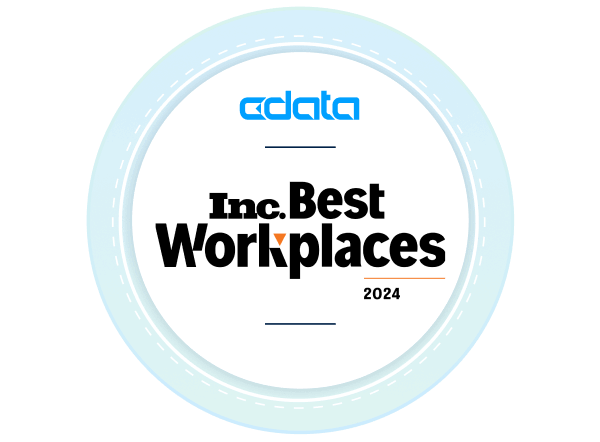Discover how a bimodal integration strategy can address the major data management challenges facing your organization today.
Get the Report →What is EDW? Exploring the Power of Enterprise Data Warehouse
Effectively storing, managing, and analyzing data is crucial for making informed decisions that drive growth and efficiency. This is where an enterprise data warehouse (EDW) becomes indispensable. An EDW is designed to store and analyze all of an organization’s business data, offering a comprehensive solution for better decision-making. In this article, we’ll delve into what an EDW is, its benefits, various architectures, and popular solutions.
What is an enterprise data warehouse (EDW)?
An enterprise data warehouse (EDW) is a centralized repository that consolidates a company's historical business data from multiple sources and applications. It is typically a collection of databases that store structured data, enabling businesses to perform complex queries and generate insights across the organization.
There are two main types of EDW:
- On-premises EDW: This type of EDW is hosted within the company's own data centers. It offers greater control over data and infrastructure but requires significant capital investment and maintenance.
- Cloud EDW: Hosted on cloud platforms, this type of EDW offers scalability, flexibility, and cost-efficiency. Cloud EDWs are maintained by third-party providers, reducing the need for in-house IT resources.
For a deeper dive into factors to consider when choosing the best data warehousing solution for your business, read our article on the benefits and challenges of data warehousing.
Enterprise data warehouse vs. data warehouse
While the terms "enterprise data warehouse" and "data warehouse" are often used interchangeably, there are subtle differences. An EDW typically refers to a more comprehensive and integrated solution that serves the entire organization, whereas a data warehouse might be narrower in scope, focusing on specific departments or functions. The distinction is mainly semantic, as both serve the purpose of storing and analyzing data.
6 Enterprise data warehouse benefits
Implementing an EDW offers numerous advantages for businesses. Here are some key benefits:
- Centralized repository: An EDW serves as a single source of truth by consolidating data from various sources. This centralized repository simplifies data management, reduces redundancy, and ensures consistency across the organization.
- 360-degree company view: With data from different departments and functions integrated into one system, an EDW provides a comprehensive view of the company's operations. This holistic perspective enables better strategic planning and decision-making.
- Improved data accessibility: An EDW enhances data accessibility by allowing users across the organization to access and analyze data easily. This democratization of data fosters a data-driven culture and empowers employees to make informed decisions.
- Increased ROI: By leveraging the insights gained from an EDW, businesses can optimize operations, identify new opportunities, and improve customer satisfaction. These improvements lead to increased return on investment (ROI) and competitive advantage.
- Enhanced data quality & security: EDWs implement stringent data quality and security measures to ensure the integrity and protection of business data. They also enable data consumers to audit data sources directly. This results in more accurate insights.
- Ensured compliance: Consolidating your organization’s data into a single data warehouse streamlines compliance efforts, alleviating the need to build a process that checks data in scattered locations.
Enterprise data warehouse architecture
There are three primary types of EDW architectures, each with its own characteristics and use cases:
- One-tier architecture: In a one-tier architecture, the database and data processing layers are combined into a single layer. This architecture is simple and cost-effective but may not scale well for large volumes of data or complex queries.
- Two-tier architecture: A two-tier architecture separates the database layer from the data processing layer. This separation improves performance and scalability compared to the one-tier architecture, making it suitable for medium-sized data environments.
- Three-tier architecture: The three-tier architecture is the most robust and scalable, consisting of a database layer, data processing layer, and presentation layer. This architecture supports large volumes of data, complex queries, and multiple user interfaces, making it ideal for enterprise-level implementations.
5 Enterprise data warehouse solutions
There are several EDW solutions available, each offering unique features and capabilities. Here are five popular options:
Amazon Redshift
Amazon Redshift is a fully managed data warehouse service in the cloud. It offers fast query performance, scalability, and integration with other AWS services, making it a popular choice for businesses of all sizes.
Google BigQuery
Google BigQuery is a serverless, highly scalable, and cost-effective multi-cloud data warehouse. It allows for real-time data analysis and integration with Google Cloud services, providing a powerful solution for data-driven organizations.
Snowflake
Snowflake is a cloud-based data warehousing solution that offers separate storage and compute resources, enabling scalability and flexibility. It supports diverse data types and workloads, making it a versatile choice for modern data environments.
SAP BW/4HANA
SAP BW/4HANA is a next-generation data warehouse solution from SAP, designed to run on the SAP HANA in-memory database. It offers real-time analytics, simplified data modeling, and integration with SAP's extensive suite of business applications. SAP BW/4HANA is ideal for organizations looking to leverage their existing SAP infrastructure and gain deeper insights into their business data.
Datavail
Datavail is a managed services provider that specializes in data management, including EDW solutions. Datavail offers expertise in database management, analytics, and business intelligence. They provide tailored EDW solutions that cater to the specific needs of businesses, ensuring optimal performance, security, and scalability.
Integrate an enterprise data warehouse with CData
Implementing an EDW can be streamlined with the right tools. CData Sync is an ideal solution for integrating an EDW into your business. It allows you to connect, synchronize, and replicate data from various sources to your EDW seamlessly. With CData Sync, you can ensure that your data is always up-to-date and accessible, empowering your organization to make data-driven decisions.
Explore CData Sync
Get a free product tour to explore how you can get powerful data integration pipelines built in just minutes.
Tour the product



